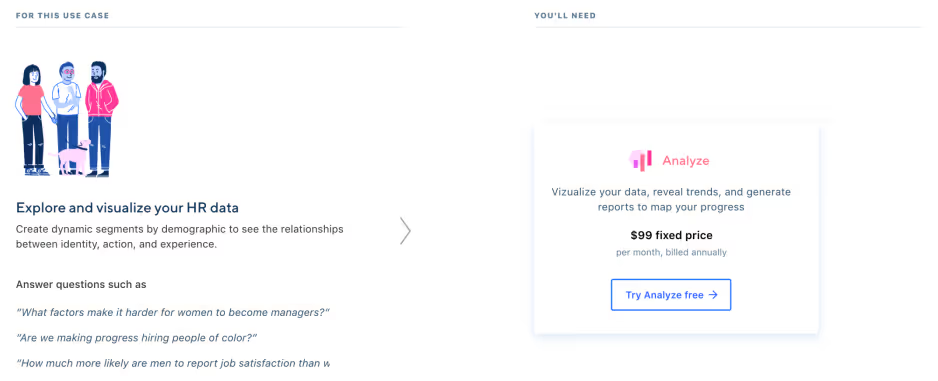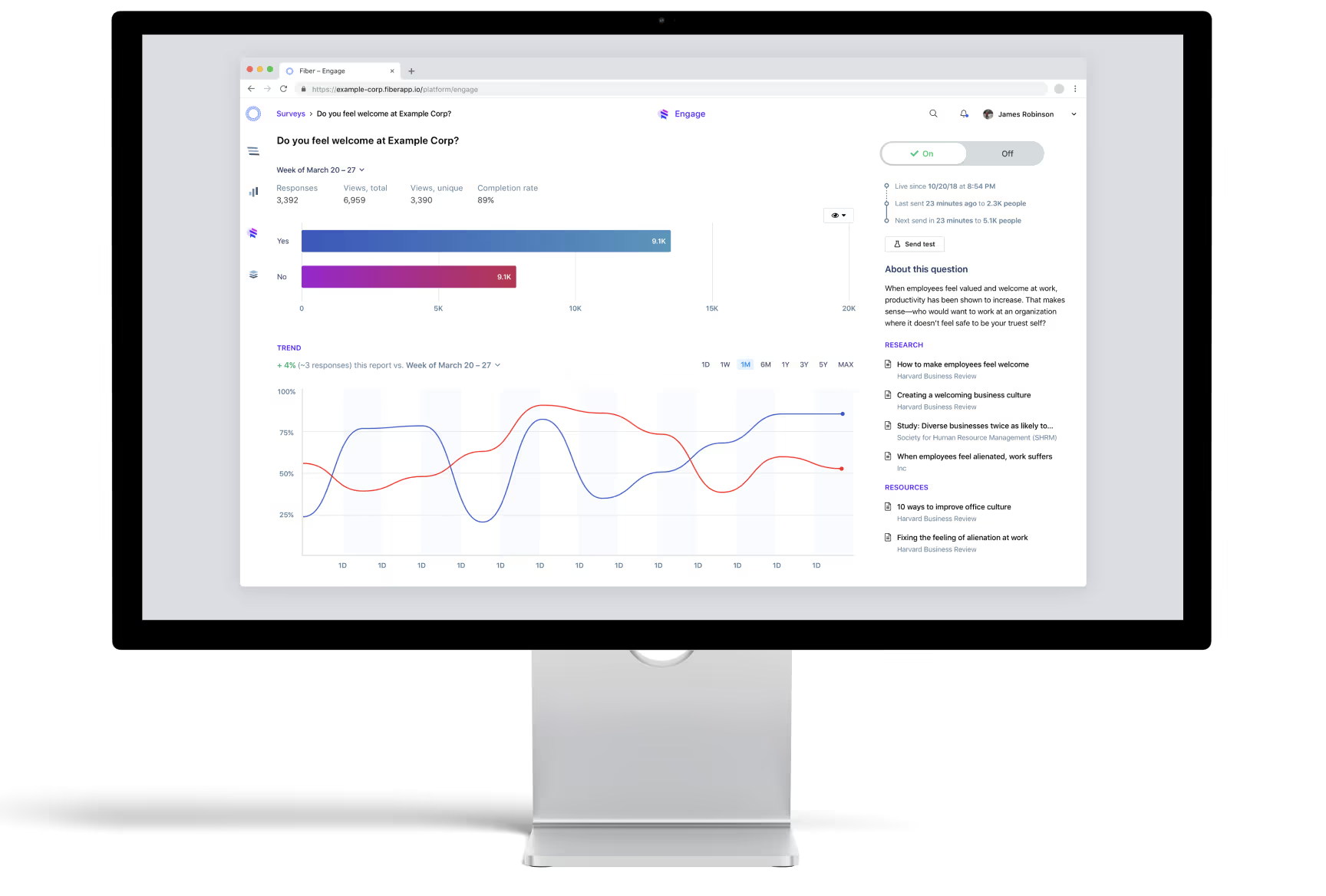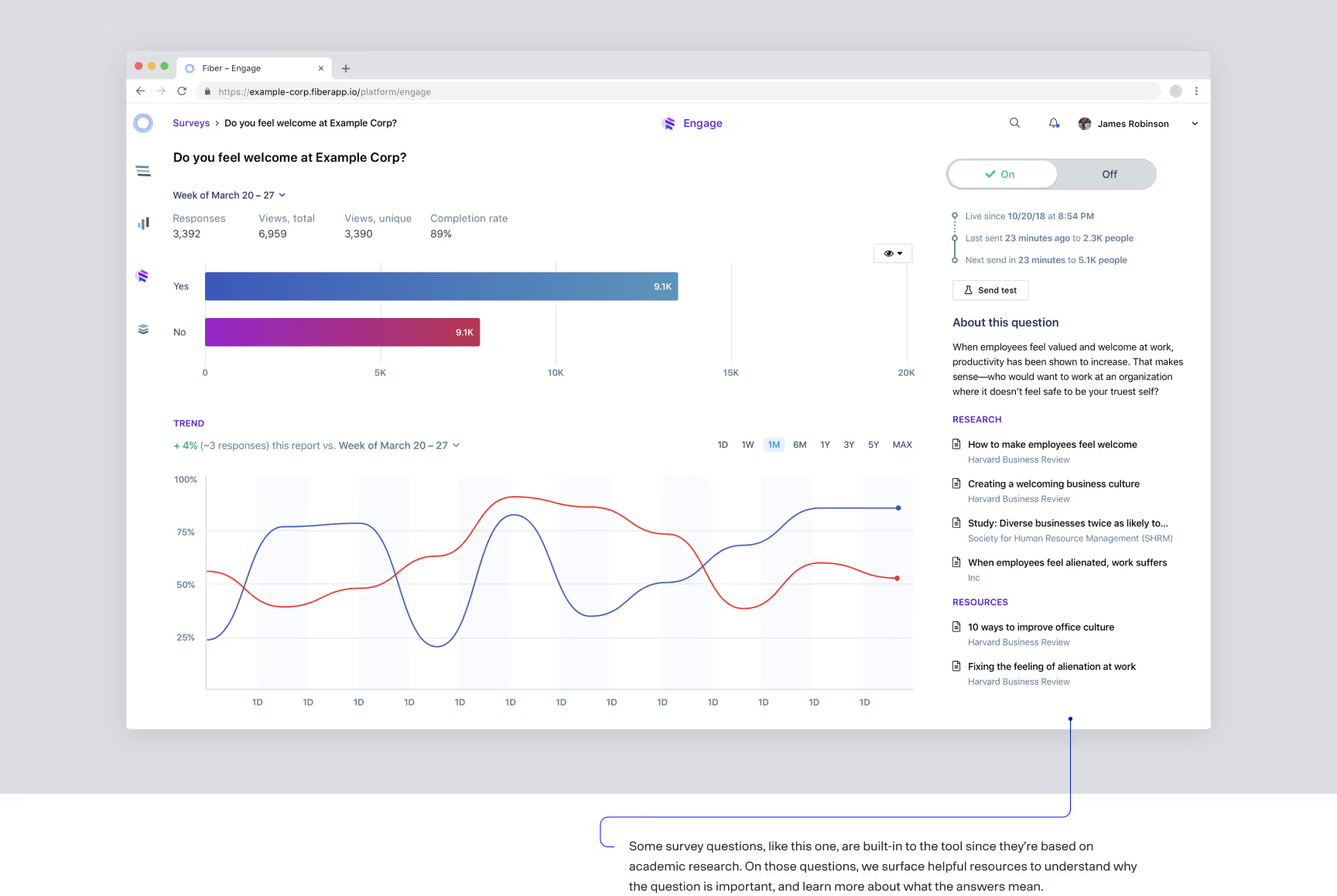Biases cost businesses $16T (a figure larger than the annual household income of all Americans) in 2020 alone. How might we create a product that identify how these occur to disrupt them in real time?

Fiber was an early-stage startup on a mission to build a more equitable, just, and inclusive future. Much of our work focused on researching how we could make a positive impact against this extremely difficult challenge.
Ultimately, our product was a B2B SaaS web app that companies would deploy to accelerate their D&I efforts from quarterly or yearly feedback cycles to as little as minutes. Just as salespeople use Salesforce all day, we aimed to be the go-to software for D&I professionals and HR departments doing this work.
Fiber shut down in 2019.
I founded Fiber in 2016 with one of my closest friends from college. We knew we wanted to build a startup, and looked around for the biggest problem we could try to address. Through experience interacting with D&I initiatives in large companies like Google and through academic coursework and research, it was clear that there was no bigger challenge than making the world more just, equitable, and inclusive.
Fiber was an early-stage startup on a mission to build a more equitable, just, and inclusive future. Much of our work focused on researching how we could make a positive impact against this extremely difficult challenge.
Ultimately, our product was a B2B SaaS web app that companies would deploy to accelerate their D&I efforts from quarterly or yearly feedback cycles to as little as minutes. Just as salespeople use Salesforce all day, we aimed to be the go-to software for D&I professionals and HR departments doing this work.
Fiber shut down in 2019.
I founded Fiber in 2016 with one of my closest friends from college. We knew we wanted to build a startup, and looked around for the biggest problem we could try to address. Through experience interacting with D&I initiatives in large companies like Google and through academic coursework and research, it was clear that there was no bigger challenge than making the world more just, equitable, and inclusive.
A quick note about financial case studies
The designs below are concepts that include placeholder, randomized data for illustrative purposes. Any similarity to real life events are purely coincidental. Nothing contained herein is or should be construed as investment advice, legal advice, solicitation or encouragement to conduct any financial transaction, advertising for any current or future offering of any token or security, or knowledge of a company's future token or security offering plans.
A staggeringly huge problem
There are few human problems more intractable and impactful than prejudice, bias, and discrimination
These manifest in a range of ways, from the brazenly overt (hate crimes, slurs, etc.) to the microscopically subtle (micro-aggressions and unconscious bias). Increasingly, it’s more the latter, so it’s understandable why so many don’t realize the scale of the problem. But in many ways, it’s this type of prejudice that’s so insidious; it’s so hard to identify and fix.
In aggregate, at a societal level, it represents perhaps the biggest problem in the world. That’s truly no exaggeration; because it affects every aspect of individual and public outcomes, such as lifespan, lifetime earning, incarceration rates, what gets built, who gets to make the rules, and so much more, its impact is literally everywhere. And since it plays out in the way that the rules of society work—the design of how incentives work—its ultimate impact is to what gets incentivized.
Prejudice’s cost to human lives is unquantifiable, but in dollar terms, it’s costing the US economy sixteen trillion dollars according to Citigroup. Think about that. That’s more than the annual household income of all American families that we’re losing. Each year.

It’s a profoundly hard problem to solve, both due to scale and the type of problem that it is: it’s evolutionarily hard-wired into human psychology and baked into human societal structures. As a species, we’ve spent millennia building these systems.
How might we go about helping to dismantle them?

Where can intervention be most effective?
As we studied this problem, we realized that there are three key places where prejudice is learned and unlearned:
- At home (mileage varies substantially)
- At schools (mostly applicable in liberal geographies)
- At work (mostly through unconscious bias programs)
In our research we found that workplaces, followed closely by universities, represented the most fertile ground to bring about change for several reasons:
- Workplace D&I programs are relatively well-funded, representing a strong enough market to build a robust solution
- It’s where people spend the majority of their lives, so we have a long period over which to make an impact
- Workplace outcomes have uniquely long-term impacts in the way that careers, and therefore, family livelihoods, are impacted
Research insights
D&I pros do this work every day. We went to them for exploratory research to discover what was working, and what wasn’t
We started hearing some consistent answers.
“The biggest challenge in my role? Getting data. It's really hard to know where to spend resources, or to justify that to leadership. It's so hard to know if what I'm doing is working.”
Addressing diversity and inclusion is actually more a scalability problem than anything else. Even at modest scales, D&I professionals’ effectiveness declines rapidly with organization size.
Business financials
Could we make it a viable business?
From the beginning, our focus was on impact, not financials, and definitely not profit. But when it came time to formalize our company legally, we made an intentional choice to incorporate as a regular Delaware C-corp, not a non-profit.
We wanted to avoid the pitfalls that so many prior efforts have fallen prey to: a constantly variable appetite for grant writing from donors, the distraction of looking for grants, challenges recruiting and retaining top talent, etc.—all things that a typical venture business could avoid. Becoming profitable also meant that we would have proved something else—that this was an area worth further investment.

There was a lot of reason for confidence from a market standpoint. Enterprise spending on SaaS was on the rise and large enough that a nominal cost of $10/employee seemed readily doable to our target customer.

Additionally companies were spending more than ever on D&I programs, a budget that we’d be competing for a slice of:



Product definition
What is Fiber?
Fiber is the first all-in-one platform designed for diversity and inclusion. Fiber makes it easy for anyone to understand how bias, discrimination, and prejudice are impacting their organization, how to change it, and how well those changes are working.
It's an analytics and communication tool...
At its fundamental level, the practical problem D&I efforts aim to solve is that different groups of people—such as males and females—experience different outcomes based on characteristics unrelated to their ability or performance. Analyzing disparity—what D&I pros often call “differential outcomes analysis”—is a large part of D&I work.
...not a compliance tool
When we pitched Fiber to people, it was common for them to mistakenly assume it’s a compliance tool. This was a very interesting assumption for people to draw, and in a lot of ways, it really illustrates a problem Fiber is designed to combat: the assumption that D&I is all about not getting sued. D&I pros we spoke to were frustrated about this common misconception, too.
.avif)
Here's how it works
Fiber is a SaaS web application with two sides: the main one is for D&I pros, and it’s a single home for much of the work they do every day. The other side is for employees, students, volunteers, even the public—they’re the members of the community the D&I pro serves.

Our research revealed that there are a few key things D&I pros do every day. Fiber includes an app for each of them:

Let’s explore a typical daily workflow for a D&I manager moving through each app to create segments of people, analyze their outcomes, engage them with a survey, and roll out education materials to respond to the results.
Traditional analytics tools combine two types of data: people and events (actions)
In most analytics visualizations, people are on one axis of an X/Y graph, with events—the actions they take—on the other. The Explore tool covers the people part. But how can we know what actions they take, what they believe, and how that changes over time? This was the critical use case D&I professionals identified.
In our work we developed a classification system for 4 kinds of data:

Privacy was always our top consideration when designing this system. We thought deeply about how to balance the positive impact integrating these datapoints could have, with the very real downsides if it were misused. We were committed to not building yet another workplace surveillance tool. That’s not what Fiber is. Because of the way Fiber works, most of this data would never be shown to a human except in an aggregated form.
The holy grail for us was always real-time AI-generated insight
In order to identify bias, we have to understand the relationship between people. Some of this data is role-based, and in existing HR payroll tools. But much of it is more abstract. It’s about how people interact, share information, and work together.
Andrew Chen, in an episode of the podcast Inside Intercom, speaks about how one of the greatest opportunities today is in leveraging “the workplace social graph”. As he points out, a robust dataset of these kinds of relationships already exists within companies’ existing workflows and tools.
By comparing this kind of data to employee identities, we could build (in the aggregate) a statistical model to correlate identity attributes and experience. Paired with data from HR and from employees (more on this below), this observed data could, for the first time, show in real time how identity affects employee experience, productivity, retention, and more.
“There’s an interesting workplace graph based on all the people you’re working on projects with and documents you’re editing together. I think that Dropbox, Slack…are the start of a tidal wave of software products within the enterprise that really understand the relationships between people.”

Engage is a chat engagement tool designed specifically for D&I. It runs surveys, but it also does so much more.
Companies spend thousands of dollars on customer intelligence and engagement tools. Tools like Intercom or Zendesk that let a business talk to customers to qualify sales leads, collect feedback, and resolve requests for support.
Engage is like that, but instead of customer-facing, it faces inward—toward your organization’s people.

Two design decisions make Engage uniquely valuable for D&I use cases:

Based on segmentation architecture
Previously, D&I and HR pros must use either generic survey tools like Qualitrics or SurveyMonkey, or performance management or payroll HR products like Lattice or Gusto. None of these can correlate survey responses to demographic characteristics like race, gender, etc. without explicitly asking respondents to self-identify. This self-identification step results in significant drop-off and substantial setup burden each time.
With Engage, demographic segmentation is built-in.

Designed for longitudinal datasets
The nature of D&I work is that it’s very often longitudinal—we need to track subtle changes in a population over time. Traditional research tools make this surprisingly difficult. Engage is built to track responses over time; each survey is correlated in a single longitudinal data view while preserving statistical rigor as things like the sample size change (if, say, a new employee joins the company).

The Educate app holds information. Paired with Engage and Thread, it’s a powerful way for anyone to get answers on demand to questions they might be too afraid to ask a coworker.
Customer engagement tools like Intercom and Zendesk have long had a way to create support articles. These are then automatically recommended by a bot to resolve inbound support requests without ever escalating to a human.

And when things go wrong, Educate is critical. Educate can resolve questions while preserving confidentiality, ensuring that those in a vulnerable state get the answers they need at any time, day or night.
Where do members of the organization answer these questions?


